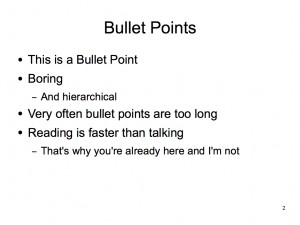When we take a look at how information is presented to us, we can see that the number three is everywhere. The “Rule of Three” is an age-old public speaking technique commonly used by politicians to give their arguments and oration more gravity, but it’s also a great lesson in presenting information in a professional setting.

Communications expert, speech coach, and regular Forbes contributor Carmine Gallo asserts that three is “the most persuasive number in communications.” In his post, he cites several historic examples, such as the famous credo of our founding fathers, “…life, liberty, and the pursuit of happiness.”
Simplicity is key if we want our audience to retain the information we present; our audience will likely only remember a handful of points we make in our presentation (somewhere between 3 and 9 things).
If you want your message to be both impactful and memorable, keep all details to their most simplified form. For this, “The Rule of 3” is an effective guideline for an easy-to-comprehend presentation.

When presenting, a common technique is to list out our thoughts or arguments as bullet points. There’s nothing inherently wrong with presenting information in this manner–although it’s by no means innovative It’s easy to get carried away when doing so because when your bullet point list grows too long, it will cause your audience to tune out.
“The Rule of Three” is more than just a way to impact your audience; it’s a cautionary reminder to not overload your audience. If you have a slide with a long list of bullet points, it is most likely time to condense this information into separate slides. Our brains have a tendency to automatically tune out when facing a daunting amount of information.
Below is an intriguing example of “The Rule of Three” used in a presentation. Apple visionary and business world demigod Steve Jobs cleverly introduced the iPhone as three separate devices before revealing all to be one device, all while using well-orchestrated repetition to hammer his point home.
In this manner, Jobs shows how “The Rule of Three” is more than just a reminder to not overload your audience with information; it’s a way to produce an aesthetic harmony within a presentation.
“The Rule of Three” is also a concept that it’s not what you say; it’s how you say it. So even though you’ve done your research and you’ve become an expert on the topic you’re presenting, you’ve still only fought half the battle.








